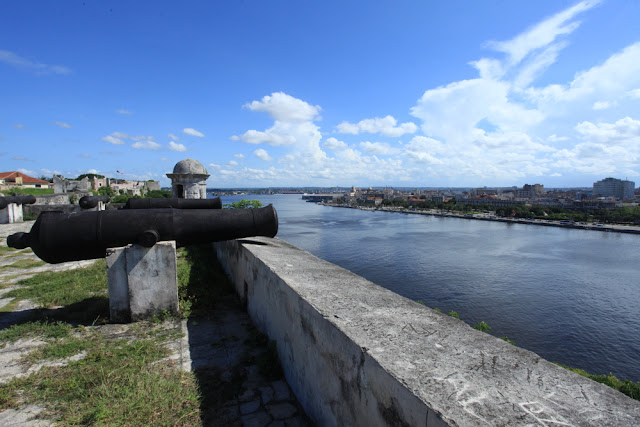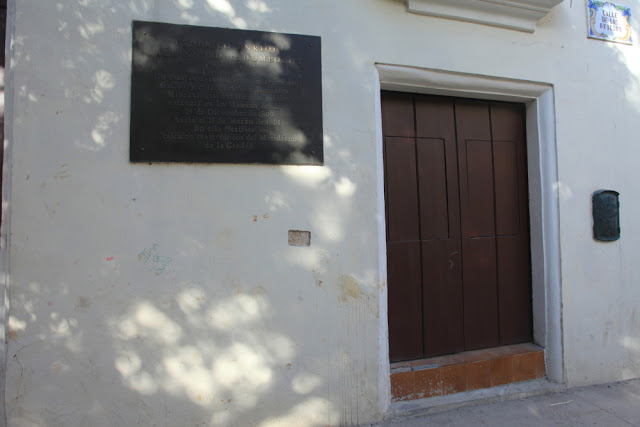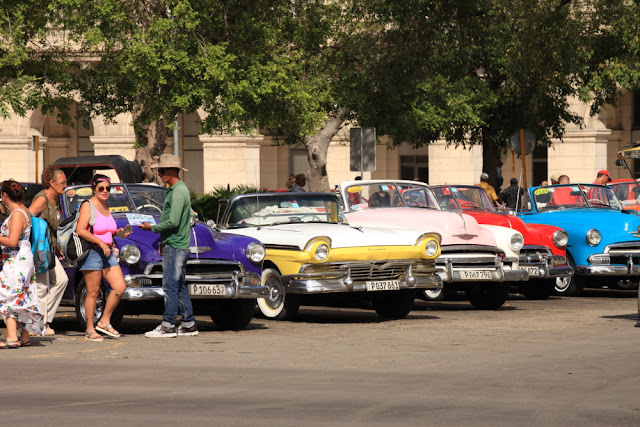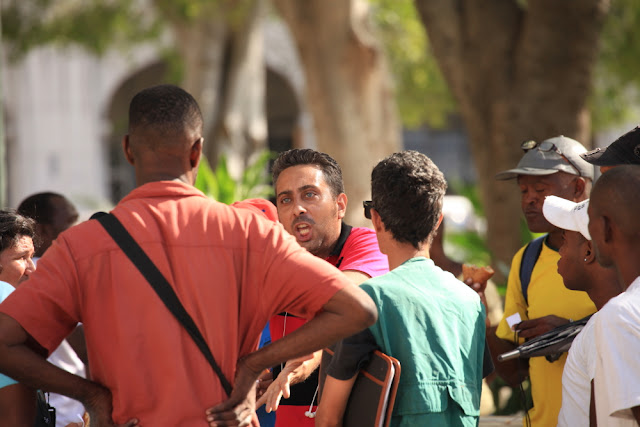The northwest corner of the island, about the size of the state of Tennessee and with 12 million inhabitants.
Monument to the Revolution on Revolution Square with a statue of the national hero, Jose Martî.
Across from the monument is the Security Service building (essentially the FBI of Cuba), replete with the image of Ernesto Ché Guevara, who helped Fidel Castro in the 1959 revolution to overthrow a dictator named Fulgencio Batista. There were not many images or political messages on signs of Fidel or Raul Castro. Like most places, people live their lives and although a discussion of politics is a precious Cuban tradition, most people's time is taken up by work, family and baseball.
The country is wonderfully clean and the highways are mostly devoid of automobiles. We did not experience gridlock anywhere in this heavily urban area - gasoline and automobiles are expensive.
Cuba's capitol building is about the size and shape of the US capitol.
Habana was first settled at this location in 1519 as one of the greatest ports in the West Indies.
Before arriving, I did not have time to research the geography of Cuba or Habana and was surprised to see what a spectacular harbor is here. In fact, the harbor is the reason for Habana's location. This is a view to the north of the harbor entrance with canon and lighthouse marking the way.
This is a view to the south looking into the expansive harbor. Habana Vieja (Old Habana) is located and partially visible on the west (right) bank. This harbor is easily defended.
The fortress is built from cut blocks of Pleistocene limestone and here a coral fossil is visible in the walls, just above the small plant.
Outside the fort, a taxi cab driver has shown his take on Cuba's future.
The next day, we took a walk through Old Habana, which is a UNESCO World Heritage Site.
"Alexander von Humboldt, 1769-1857. In this house, Humboldt set up his scientific instruments and botanical and mineralogical collections during his first stay in Habana from December 19, 1800 to the 15th of March, 1801. Here he established the mathematical calculus of the city's meridian."
Humboldt's house.
Habana Vieja morning.
Everywhere in the city, reconstruction and rehabilitation of old, dilapidated buildings is going on.This shell of an old building on town square is an example.
Public art is everywhere in this vibrant and culturally diverse city.
Here, a young girl flying a kite is intrigued with the conversation going on between a woman on a bench and the bronze statue sitting next to her.
Let's have a Cuban cigar. Why not, it's 9:30 AM.
Wall art.
Coffee only 3 centavos.
The cathedral in Cuba.
The Malecón is a beach-side drive and sidewalk that is very popular with the young crowd at night, most of whom are staring at their hand-held devices. The Malecón is 3 miles long and one of the longest in Latin America.
The following day we drove 11 miles east to visit the Cuban home of Ernest Hemmingway.
Visitors merely look through the open doors and windows into a space that is mostly unchanged from his departure in 1960.
Inside are over 9,000 books, bottles of rum and beer, newspapers, and furniture.
Hemmingway's desk where he composed "The Old Man and the Sea."
In the detached "spy tower," a painting of Hemmingway on safari in Africa sits atop a bookcase.
His boat, the Pilar, is preserved outside near the large swimming pool.
Words of wisdom we can all live by.
Hemmingway with a young Fidel in his revolutionary youth.
Woman in the market in the small village of Cajimar.
The old cars are amazing and in some areas they congregate waiting to take tourists for a ride. But it is not just tourists - locals too drive there cars of which there are thousands upon thousands.
Some are restored beautifully but most are not stock and have replaced their engines and chassis's.
There were a lot of 1952 Chevy's but some cars dated back to the early 1940's. There were also Dodge's, Ford's, and other foreign vehicles. They are everywhere.
TCS arranged for us to have a ride in one of these cars and the one I got was a 1958 Chevy Impala - the first year for the Impala.
Lot's of Buick's too.
In the Parque Central, these men looked to be having an argument. We were told by our local guides to go check it out.
The banter went back and forth...
...and became heated at times (but not violent). Turns out this is something that goes on everyday and the discussion is about Cuban baseball!
The old Bacardi Rum building in Habana is an ornate edifice. It costs 2 CUC's to ride up to the top (about $2.25). Cuba has two currencies - the CUC is for tourists and is pegged to the value of the dollar. The locals use Cuban Peso's and it is about 28 to 1 on the dollar.
The recently restored Opera House is fabulous.
And upstairs we had a grand dinner in one of the marble halls. This was a nice visit but next time I will get out into the country side a bit more. On to Cartagena and the South American continent!










































Wow! What a photo documentary! Love the old woman on the bench with the young girl looking on.
ReplyDelete